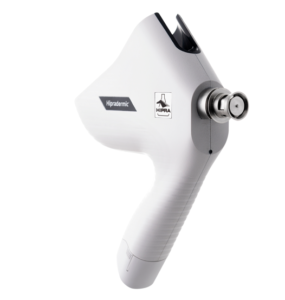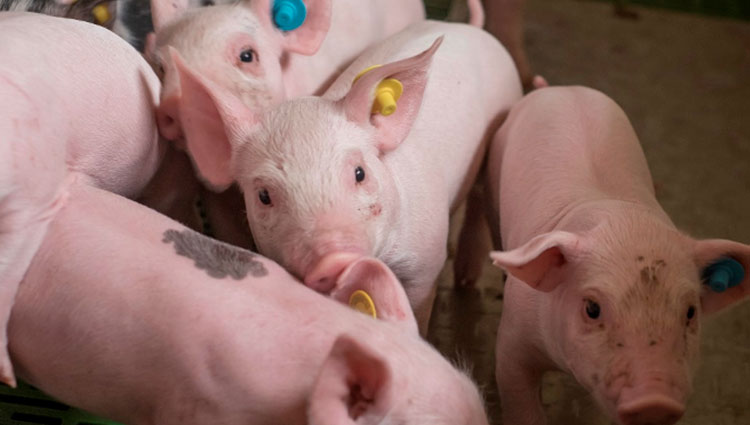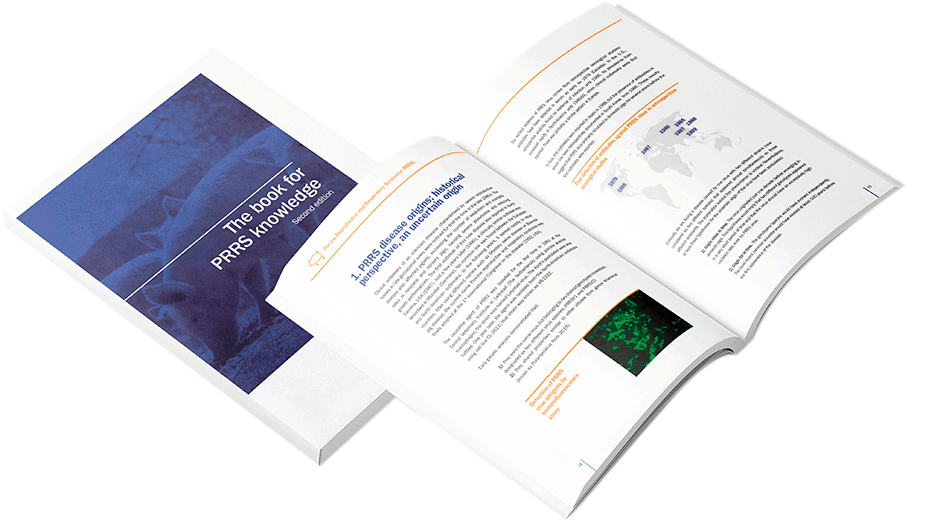Lidia de Lucas1, Salvador Romero1, Tiago Nunes1, Joel Miranda2
1Global Product Manager, HIPRA
2Global Franchise Manager, HIPRA
Control of the disease caused by the PRRS virus remains a source of frustration for all producers and veterinarians. And no wonder! The reasons why controlling the disease is so complex include the need for a multifactorial approach and the fact that no solution alone is exclusive and effective.
In the face of the difficulties posed by the PRRS virus, a disease control plan should include measures such as proper management of the animals, appropriate immunisation and a biosecurity plan that reduces the risk of external infections being brought in and recirculated internally.
There is little doubt that immunization of the replacements and of the adult sows with modified live vaccines plays a key role in the common strategy for controlling the virus. Today, 90% of breeders are vaccinated and the benefits are clear when we consider the impact of the uncontrolled disease on positive farms (€100-200 per sow/outbreak)1.
However, the new dynamics of the disease, the existence of more and more unstable positive farms and the periodic recirculation of highly pathogenic strains lead us to consider not only the vaccination of sows but also of piglets. Although the vaccination rate of piglets has significantly increased the last decade, there is still a huge percentage of piglets not vaccinated that means not protected and at risk of suffering PRRS disease.
The impact of PRRS during the post weaning period has been estimated as €3.5 for an animal weighing 30 kg2. However, it can be higher when in combination with other pathogens, either viral (Influenza virus, PCV2) or bacterial (M. hyopneumoniae, Actinobacillus pleuropneumoniae, Glaesserella parasuis, etc.), as the cost of antibiotics to control these diseases is added to the direct losses owing to associated mortality and clinical symptoms.
And as if these were not enough, there has been a marked increase in the impact of PRRS virus because of highly pathogenic strains, with high rates of mortality in the transition phase (reaching 40% and even, in exceptional cases, up to 60% mortality rate).
What benefits can we expect from the vaccination of piglets against PRRS?
The vaccination of piglets is an adequate solution when there is a high infection pressure in the nursery phase with PRRS virus circulation causing productive losses.
The benefits of piglet vaccination at short term are:
- First, the clinical control of the disease, with a reduction in clinical symptoms and an improvement in the productive parameters because of the protection of the animals against infection.
- Secondly, the epidemiological control by reducing PRRS virus viraemia and excretion, so that reduction of the infection pressure during nursery period.
- Third, reduction of problems associated to secondary infections, so that problems associated with opportunistic pathogens and the use of antibiotics is reduced.
Moreover, piglet vaccinate provides mid- and long-term benefits for the control of PRRS at whole herd level:
- The productivity of pigs at the finish period improves: if PRRS virus recirculation is controlled, piglets are healthier during the nursery phase and the health status of finishers will be better and their productivity as well.
- The stability of PRRS in the breeding herd will be longer: when vaccinating piglets, the percentage of susceptible animals is reduced. Consequently, the whole herd immunity is better prepared, and this will minimize recirculation of the virus, destabilization of the breeding herds and the farm will be better prepared for a new strain entering the farm.
What do we need to consider when vaccinating piglets?
The vaccination of piglets against PRRS is becoming an increasingly common practice as over the years the swine sector has accumulated knowledge and experience showing that vaccination protocols are successful when applied correctly.
To ensure maximum efficacy of piglet vaccination, the following must be considered:
- Vaccination should preferably be carried out at least 3 weeks before infection.
- The animals should be healthy, i.e. not viraemic.
- The piglet vaccination must be maintained during a minimum period in a farm to maximise the benefits.
A key point, therefore, will be to determine the optimal time for vaccination for each farm according to the time of infection. HIPRA has developed the Together programme, the aim of which is epidemiological and productive monitoring of PRRS piglet vaccination and therefore to quantify the economic return of investment.
As an example, we present the results of a programme carried out on a farm in Spain with 1600 F1 + F2 sows where we monitored the PRRS piglet vaccination.
After diagnostic confirmation by PCR and sequencing of field PRRSV strain circulation, with an average mortality in the nursery of 16%, it was decided to implement the intradermal vaccination of the piglets with Unistrain® PRRS at two weeks of age.
After three months of vaccination, mortality was reduced by 75% (figure 1). Moreover, 8 weeks after starting to vaccinate, the piglets were already PCR negative to PRRS at weaning and although they were still positive at the end of nursery, the sequence identified in all cases was the vaccine strain4. In addition, the consumption of antibiotics and anti-inflammatories was drastically reduced after the piglets’ vaccination started.

Figure 1. Mortality reduction in nursery after starting vaccination with Unistrain® PRRS
Furthermore, intradermal vaccination with Unistrain® PRRS (figure 2) brings other additional advantages such as a reduction in the risk of iatrogenic disease transmission5 and an improvement in the welfare of vaccinated animals6.

Figure 2. Hipradermic® device used for intradermal vaccination of Unistrains® PRRS
Is the vaccination of piglets against PRRS a profitable tool?
There is no easy answer to this question. It will depend on several factors such as the impact that the PRRS virus has on the productive performance on a particular farm, co-infections that are present and the nature of the field PRRS virus strain circulating in the farm. Even so, the experience gathered at HIPRA shows that when it is carried out in the appropriate epidemiological and clinical conditions, the vaccination of piglets is a highly profitable measure.
A recent study carried out in France answered this question following the implementation of a stabilisation protocol on a farrow-to-finish farm in a high-density swine production area.
Amongst other measures, the protocol included the immunisation of gilts (2 doses), sows (every 4 months) and piglets (two doses) with PRRS modified live vaccine.
After PRRS stabilization had been achieved, and because of this, an improvement in productive parameters and growth of the animals (see table 1) were observed as well as a reduction in the cost of medication. In that case, the return on investment of the PRRS vaccination was estimated as €4.2 per pig7.

Table 1. Evolution of reproductive, productive, and economic parameters before and after PRRS stabilization.
These results confirm that the piglet vaccination with Unistrain® PRRS is a useful and profitable tool to reduce the productive and economic impact as well as the infection pressure on PRRS infected farms, as long as it is used and adapted to the needs of each farm and always complemented by management and biosecurity measures as part of a control plan.
Bibliography
- Nieuwenhuis, N et al, 2012. Economic analysis of outbreaks of porcine reproductive and respiratory syndrome virus in nine sow herds. The Veterinary record. 170. 225. 0.1136/vr.100101.
- Miranda et al; Evaluation of the economic impact of the PRRS virus in the nursery phase. ESPHM 2021. Pag 146.
- Martín-Valls, G.E. et al. Introduction of a PRRSV-1 strain of increased virulence in a pig production structure in Spain: virus evolution and impact on production. Porc Health Manag 9, 1 (2023). https://doi.org/10.1186/s40813-022-00298-3
- Torrents, D. et al; Improvement of productive parameters after piglet PRRS vaccination. IPVS 2020. Pag 543.
- Nilubol,D et al Evaluation of ASF and PRRS virus transmission between pigs when using conventional needles and a needle-free device. IPVS 2022, Pag 677.
- Antoni Dalmau et al; Intramuscular vs. Intradermic Needle-Free Vaccination in Piglets: Relevance for Animal Welfare Based on an Aversion Learning Test and Vocalizations. Front. Vet. Sci. Volumen 8. 2021. https://doi.org/10.3389/fvets.2021.715260
- Lebret, A et al; Economic impact of a porcine reproductive and respiratory syndrome (PRRS) stabilization program in a farrow-to-finish farm using mass vaccination with a modified live vaccine and strict biosecurity measures. ESPHM 2022, pag 76.




